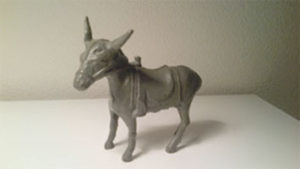
Sally of Santa Barbara wrote on behalf of her mom, who owns a cast-iron donkey toy bank used in Franklin D. Roosevelt‘s “Dimes for Dems” campaign. Sally, this bank is older than the FDR period, and more valuable.
When it comes to piggy banks we all probably remember one from our childhood. Sparking a memory of a certain place, a certain face, and a time gone by. An American invention, toy banks became incredibly popular gifts for children from post-Civil War until the 1950s. Because pennies are starter money, and money begets power, these toy banks represented power—power expressed in symbols.
Politically Incorrect Toy Banks
Toy banks echoed the zeitgeist of the times, essentially as a social commentary in a symbolic form. Take, for example, a bank representing W. Howard Taft as an egg with a top hat. President Taft (term 1909-13), a huge eater and spender, at his top heft weighed 340 pounds. A bank in the form of a tattered black sharecropper with toes showing, a message, though politically incorrect today, represents a message to the privileged. Some of these these banks are valuable. The little Taft bank at four and a half inches high sold for $750.
What happened in adult life led to the creation of thousands of irreverently designed children’s banks. Such as Teddy Roosevelt shooting a bear, or representing the “god of things as they should have been,” a “Billiken.” Thousands of figures of “Mammy,” bigger banks, held all kinds of change and thousands of figures of Native Americans held pennies, then called “Injun” banks. Ouch!
I’m fascinated by the architecturally correct toy banks, enticing good, young capitalists to invest. Millions of these existed, so detailed as to even include Victorian gingerbread.
Banks in the form of a safe intrigue me, as well as their names. What implied message lurked behind kids’ saving money? Safe banks came with names like “The Roller,” “Grand Jewel,” “Rival Bank,” “Young American,””Uncle Sam Security.” The trend in 1880 encouraged the installation of huge, iron home safes and the paranoia trickled down to the kids.
The Value of Sally’s Toy Bank
The A. C. Williams Co. made Sally’s bank from 1910-34. Unfortunately, somebody painted this one gray. The original coloring included a brown saddle and red bridle. In good condition, this donkey sells for $250. Sally’s, because of the paint job, is worth $50 to $75. Nobody ever associated Sally’s toy bank with the Democratic Party at the time. At least not sponsored by the Dems. In fact A. C. Williams poignantly marketed this bank as “The Jack Ass.” Other animal figures they made include camels, dogs, cats, lions, owls, frogs, cows, bears, rabbits, turkeys and elk. The tradition of money held by an auspicious animal goes back a long way.
The story of Sally’s bank tells a story of American ingenuity as well as American creativity. The A. C. Williams Co., founded in 1844 in Chagrin Falls, Ohio. This turned out to be an appropriately named town for the business. A. C. Williams Metals burned down twice, completely, once in 1889 and again in 1892. Up till the last fire, the company made farm machinery, not toys. But a young salesman in 1893 wanted something for a quick dime, and the cast iron toy bank was born. A. C. Williams became the largest metal toy bank manufacturer in the world until World War II. How did the most popular bank become the pig? Dogs bury bones, camels store water, squirrels hide nuts, donkeys carry treasure. Pigs save nothing. People called early, cheap clay “pygg.” Naturally, when asked to make a pygg pot, A. C. Williams and other manufacturers made pigs.
Most interesting. I especially like the explanation of the cheap clay called pygg. Somehow this rang a bell, but I had forgotten about it.
I have a green one that has a Roosevelt banner.